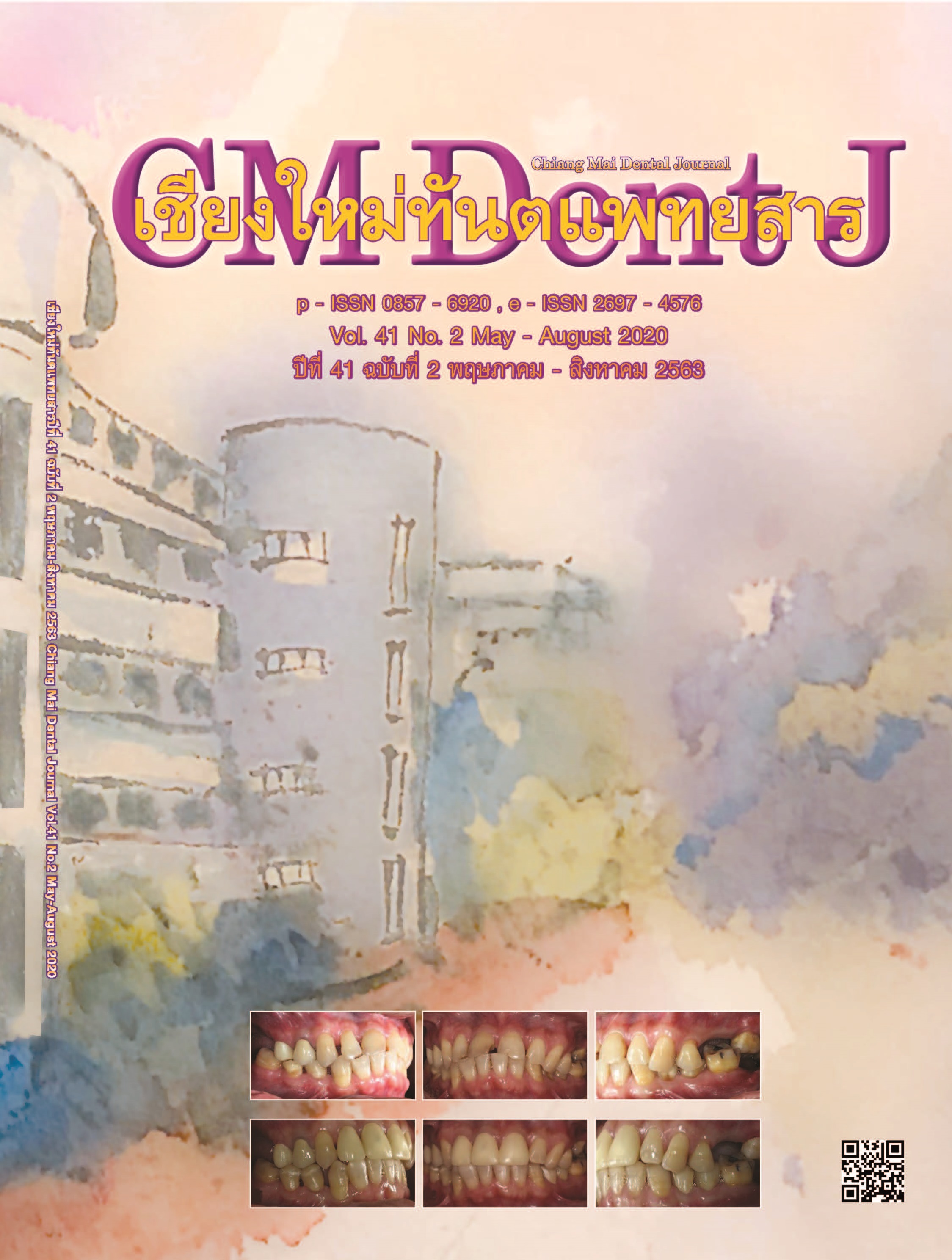Comparison of Facial Profile Esthetics of Subjects with Bimaxillary Protrusion, as Preferred by the Subjects, Orthodontists and Laypersons
Main Article Content
Abstract
Introduction: The purposes of this study were to compare preferred facial profiles of subjects with bimaxillary protrusion produced by a 3-D facial light scanner between subjects, orthodontists and laypersons.
Methods: Facial images were recorded for 44 Thai subjects with bimaxillary protrusion. A computer program which combined cephalometric radiographs and 3-D photographic images was used to produce five modified profiles by retroclining and retruding the maxillary central incisors. The subjects ranked only their own facial profiles. Eighteen orthodontists and 30 laypersons ranked all profiles. The position of the upper and lower lips in relation to the E-line was measured on the most preferred images.
Results: The majority of observers in all of the groups chose the images at 50% of profile change, -2.11 to -1.99 mm for the upper lip to E-line, and -1.74 to -1.48 mm for the lower lip to E-line, as the most esthetic preferences. There were no significant differences in preferred facial profiles or lip position.
Conclusions: All three groups of observers preferred the same facial profiles, a slightly retruded upper and lower lip in relation to the E-line.
Article Details
References
Mesaros A, Cornea D, Cioara L, Dudea D, Michaela Mesaros, Badea M. Facial Attractiveness Assessment using Illustrated Questionnairers. Clujul Med 2015; 88(1): 73–78.
Giddon DB. Orthodontic applications of psychological and perceptual studies of facial esthetics. Semin Orthod 1995; 1(2): 82–93.
Abu Arqoub SH, Al-Khateeb SN. Perception of facial profile attractiveness of different antero-posterior and vertical proportions. Eur J Orthod 2011; 33(1): 103–111.
Bills DA, Handelman CS, BeGole EA. Bimaxillary dentoalveolar protrusion: traits and orthodontic correction. Angle Orthod 2005; 75(3): 333–339.
Leonardi R, Annunziata A, Licciardello V, Barbato E. Soft tissue changes following the extraction of premolars in nongrowing patients with bimaxillary protrusion. A systematic review. Angle Orthod 2010; 80(1): 211–216.
Lamberton CM, Reichart PA, Triratananimit P. Bimaxillary protrusion as a pathologic problem in the Thai. Am J Orthod 1980; 77(3): 320–329.
Chu YM, Bergeron L, Chen YR. Bimaxillary protrusion: an overview of the surgical-orthodontic treatment. Semin Plast Surg 2009; 23(1): 32–39.
Choi JY, Kim T, Kim HM, Lee SH, Cho IS, Baek SH. Effect of frontal facial type and sex on preferred chin projection. Korean J Orthod 2017; 47(2): 108–117.
Park NS, Park JH, Bayome M, Mo SS, Kim Y, Kook YA. An evaluation of preferred lip positions according to different age groups. Int J Oral Maxillofac Surg 2013; 42(5): 637–642.
Shimomura T, Ioi H, Nakata S, Counts AL. Evaluation of well-balanced lip position by Japanese orthodontic patients. Am J Orthod Dentofacial Orthop 2011; 139(4): 291-297.
Mantzikos T. Esthetic soft tissue profile preferences among the Japanese population. Am J Orthod Dentofacial Orthop 1998; 114(1): 1–7.
Maple JR, Vig KWL, Beck FM, Larsen PE, Shanker S. A comparison of providers’ and consumers’ perceptions of facial-profile attractiveness. Am J Orthod Dentofacial Orthop 2005; 128(6): 690–696.
Cao L, Zhang K, Bai D, Jing Y, Tian Y, Guo Y. Effect of maxillary incisor labiolingual inclination and anteroposterior position on smiling profile esthetics. Angle Orthod 2011; 81(1): 121–129.
Kim SH, Jung WY, Seo YJ, Kim KA, Park KH, Park YG. Accuracy and precision of integumental linear dimensions in a three-dimensional facial imaging system. Korean J Orthod 2015; 45(3): 105–112.
Margolis MJ. Esthetic considerations in orthodontic treatment of adults. Dent Clin North Am 1997; 41(1): 29–48.
Farrow AL, Zarrinnia K, Azizi K. Bimaxillary protrusion in black Americans--an esthetic evaluation and the treatment considerations. Am J Orthod Dentofacial Orthop 1993; 104(3): 240–250.
Miyajima K, McNamara JA, Kimura T, Murata S, Iizuka T. Craniofacial structure of Japanese and European-American adults with normal occlusions and well-balanced faces. Am J Orthod Dentofacial Orthop 1996; 110(4): 431–438.
Chong HT, Thea KW, Descallar J, et al. Comparison of White and Chinese perception of esthetic Chinese lip position. Angle Orthod 2014; 84(2): 246–253.
Surachai D, Jiraporn C, Pornrachanee S, Niwat A, Narumol T. Thai Adult Norms in Various Lateral Cephalometric Analysis. J Dent Assoc Thai 1994; 44(5–6): 202–214. (in Thai)
Ioi H, Shimomura T, Nakata S, Nakasima A, Counts AL. Comparison of anteroposterior lip positions of the most-favored facial profiles of Korean and Japanese people. Am J Orthod Dentofacial Orthop 2008; 134(4): 490–495.
Soh J, Chew MT, Wong HB. A comparative assessment of the perception of Chinese facial profile esthetics. Am J Orthod Dentofacial Orthop 2005; 127(6): 692–629.
Türkkahraman H, Gökalp H. Facial profile preferences among various layers of Turkish population. Angle Orthod 2004; 74(5): 640–647.
Alley TR, Cunningham MR. Article Commentary: Averaged Faces Are Attractive, but Very Attractive Faces Are Not Average. Psychol Sci 1991; 2(2): 123–125.
Ioi H, Nakata S, Nakasima A, Counts A. Effect of facial convexity on antero-posterior lip positions of the most favored Japanese facial profiles. Angle Orthod 2005; 75(3): 326–332.
Skinazi GL, Lindauer SJ, Isaacson RJ. Chin, nose, and lips. Normal ratios in young men and women. Am J Orthod Dentofacial Orthop 1994; 106(5): 518–523.
Hockley A, Weinstein M, Borislow AJ, Braitman LE. Photos vs silhouettes for evaluation of African American profile esthetics. Am J Orthod Dentofacial Orthop 2012; 141(2): 161–168.


